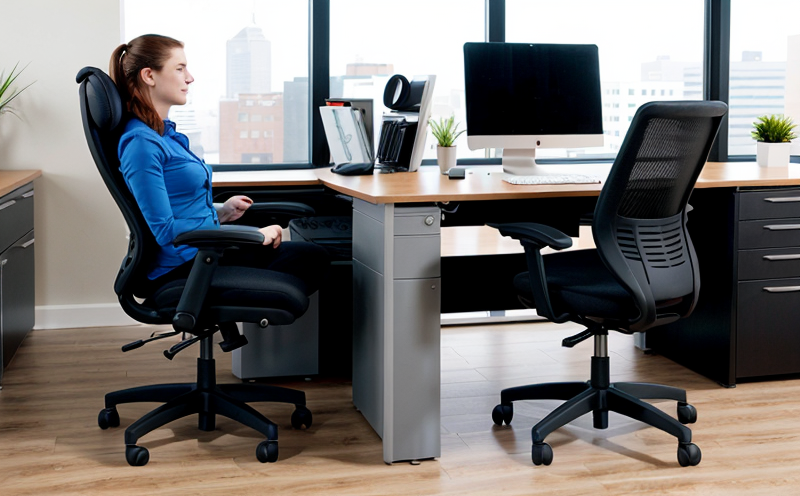BS EN 1335-3 Office Work Chairs Strength and Stability Testing
The BS EN 1335-3 standard is a critical benchmark for ensuring the safety, comfort, and durability of office work chairs. This standard applies specifically to office work chairs that are designed for use in offices and similar environments where prolonged sitting is common. The primary focus of this test is to evaluate the strength and stability of these chairs under various loading conditions.
The test covers several key aspects including structural integrity, load-bearing capacity, and resistance to collapse or deformation. Compliance with this standard ensures that office work chairs meet the highest safety standards, thereby protecting users from potential injuries caused by chair failure during use.
During testing, a series of standardized load applications are performed on the chair to simulate typical usage scenarios such as sitting, leaning back, and moving around the workspace. The test conditions are designed to mimic real-world situations where chairs are subjected to various stresses over time. This includes static loads (loads applied for a long period) and dynamic loading (loads that change over time).
The testing process involves several critical steps:
- Preparation of the specimen in accordance with the standard.
- Application of specified loads to different parts of the chair, including the seat pan, backrest, armrests, and legs.
- Observation of any signs of failure or deformation under load.
The acceptance criteria for this test are stringent. The chair must not show any visible signs of damage, such as cracks, splits, or deformations that could affect its functionality or safety. Additionally, the chair should maintain its stability and structural integrity throughout the testing process.
| Test Parameter | Description |
|---|---|
| Static Load Application | Application of a specified load to the chair for a defined period. |
| Dynamic Load Application | Application of a load that changes over time, simulating real-world usage conditions. |
| Loading Points | The specific areas on the chair subjected to loading during testing. |
| Load Values | The exact loads applied in kilopascals (kPa). |
| Test Duration | The time period over which tests are conducted, typically ranging from several hours to overnight. |
Compliance with the BS EN 1335-3 standard ensures that office work chairs meet industry best practices and regulatory requirements. This not only enhances user safety but also contributes positively to workplace ergonomics by promoting comfort and reducing musculoskeletal disorders.
Eurolab Advantages
Eurolab offers unparalleled expertise in the field of office furniture testing, particularly for BS EN 1335-3 compliance. Our team of highly skilled engineers and technicians ensures that all tests are conducted with precision and accuracy, providing reliable results that meet international standards.
- Comprehensive Testing Capabilities: We offer a full range of testing services for office furniture, including strength and stability testing as per BS EN 1335-3.
- State-of-the-Art Facilities: Our laboratories are equipped with the latest equipment and instrumentation to ensure accurate and repeatable test results.
- Experienced Staff: Our team comprises professionals with extensive experience in furniture testing, ensuring that all tests are conducted according to best practices.
- Rapid Turnaround Times: We understand the importance of timely delivery of test reports. Therefore, we strive to provide results within industry-standard timelines.
At Eurolab, we pride ourselves on our commitment to quality and customer satisfaction. Our services are designed to help you meet your regulatory requirements while ensuring that your office furniture meets the highest standards of safety and performance.
Environmental and Sustainability Contributions
The BS EN 1335-3 standard is not only about ensuring the immediate safety of users but also contributes to broader environmental sustainability goals. By adhering to this standard, manufacturers can significantly reduce the risk of injuries due to chair failure, which in turn reduces healthcare costs and improves worker productivity.
- Minimized Risk: Reduces the likelihood of accidents that could lead to long-term health issues or even fatalities.
- Increased Product Lifespan: Stronger chairs last longer, reducing waste and resource consumption.
- Enhanced Comfort: Ergonomic design ensures users are comfortable for extended periods, leading to better overall well-being.
The testing process itself also contributes to sustainability. By identifying weak points early in the development process, manufacturers can optimize designs and materials, reducing material waste during production.
Use Cases and Application Examples
This test is essential for any manufacturer of office work chairs who wants to ensure their products meet international standards. Here are some specific applications:
- New Product Development: This test helps manufacturers identify potential weaknesses in new designs before they reach the market.
- Compliance Audits: Regular testing ensures that existing production lines continue to meet regulatory requirements.
- Customer Satisfaction: Meeting or exceeding industry standards enhances customer trust and satisfaction.
The following table outlines some key use cases and their associated application examples:
| Use Case | Application Example |
|---|---|
| New Product Development | Testing prototypes before mass production. |
| Compliance Audits | Annual testing of existing models to ensure ongoing compliance. |
| Customer Satisfaction | Incorporating test results into marketing materials to demonstrate product quality. |





